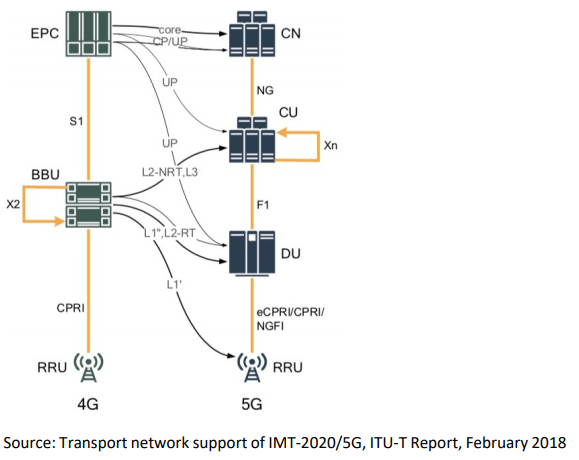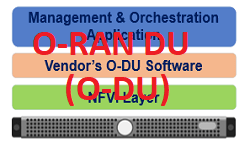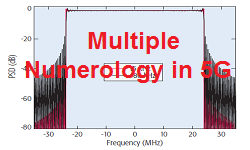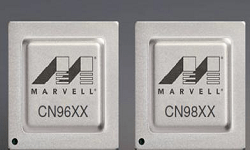5G ORAN Network Architecture Elements
ORAN Introduction
ORAN network architecture is needed to address the specific needs of different mobile operators around the world and it is expected that vendors will interoperate to create customized Open RAN solutions to meet these requirements. The following graphic shows the 4G RAN and core network as compared to the 5G RAN and core.

ORAN 5G Architecture
The 5G NR with respect to 3GPP Release 15 and later, the specifications require the RAN to become disaggregated grouping of functional elements. The gNB which is a 5G base station, is comprised of following functional units:

- Open Radio Unit (O-RU): Open Radio Unit (O-RU) which comprises the RF chain, to transmit or receive the over-the-air signal and provide corresponding transformation of the analog radio signal and the digital signals. It connects through the fronthaul to Open Distributed Unit (O-DU). The details on reference architecture for O-RU is available here.
- Open Distributed Unit (O-DU): The Open Distributed Unit (O-DU) which handles the lower layers of the baseband processing up through the PDCP layer of the protocol stack. In legacy RAN systems, this runs on a proprietary vendors hardware, but today’s software are capable to run on COTS hardware, allows this function to be virtualized. Since it is virtualized, this gives flexibility in terms of placing the processes at different locations which may include the cell site, far edge locations and/or the centralized locations. These functional layer splits are defined in the 3GPP specifications and their placement is selected based on type of transport network (fibre, microwave etc.) available to the cell sites. The details on reference architecture for O-DU is available here.
- Open Centralized Unit (O-CU): Open Centralized Unit (O-CU) handles all higher layer functions of the protocol stack from PDCP and functions such as the functions of RRC, PDCP, SDAP, X2-U, F1-U, NG-U, S1-U, X2AP (X2-C), F1AP (F1-C), NGAP (NG-C), S1AP (S1-C) and OAM. O-CU software shall be capable to run on X86/ARM processors.
Open RAN Benefits
- Lower Expenditure: Open RAN reduce both CapEx and OpEx cost
- Lower Deployment Time: with virtualized RAN, benefits like automation can reduce the average time for deploying a site. And a virtualized RAN combined with Centralization can be deployed faster than a traditional
architecture since the only site installation required is for the radio and power. - Easy Upgrade with no inter vendor Dependency : Easy upgrade options from multiple vendors enables future-proof network evolution. MNOs do not have to depend on the roadmap evolution of a single vendor to roll out new features.
- Minimum Vendor Lock-In: Open RAN minimizes the danger of vendor lock-in. Open RAN vendor’s equipment will work with the incumbent and future vendors’ solutions
- Easy to Scale: Open RAN disaggregation of hardware from software can enable carriers to respond more quickly and in a more targeted fashion to increase/decrease or relocate capacity.
- Ability to add Massive Scale: If required, Open RAN network can be added Massive Scale using web scale approach. Since edge computing is being deployed by service providers around the world, the edge compute architecture can be utilized for Open RAN – Containers (CNFs) and can be used to push changes using automation to the network, using the DevOps model. This indicates that the RAN is essentially following the same development curve as the data center did, with the corresponding benefits.
References
- O-RAN Specification : WG4 – Open Fronthaul Interfaces Workgroup
- TIP Whitepaper
- Parallel Wireless White Paper: Open RAN Integration: Run with it
Related Post
- O-RAN Fronthaul Spilt Option 7-2x
- O-RAN Fronthaul C/U, Synchronization and Management Planes
- O-RAN Fronthaul Protocols Stack
- O-RAN Fronthaul Delay Management



